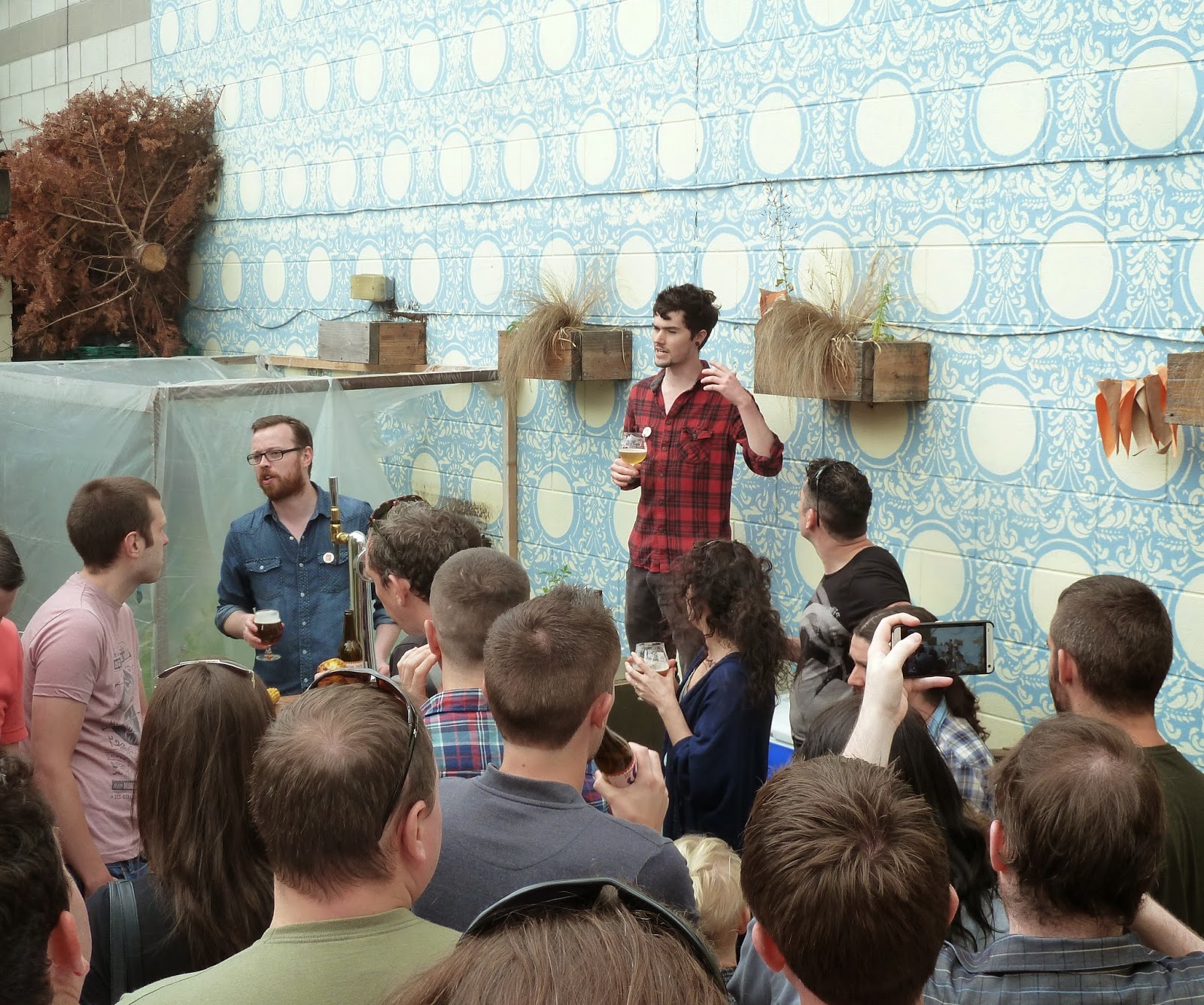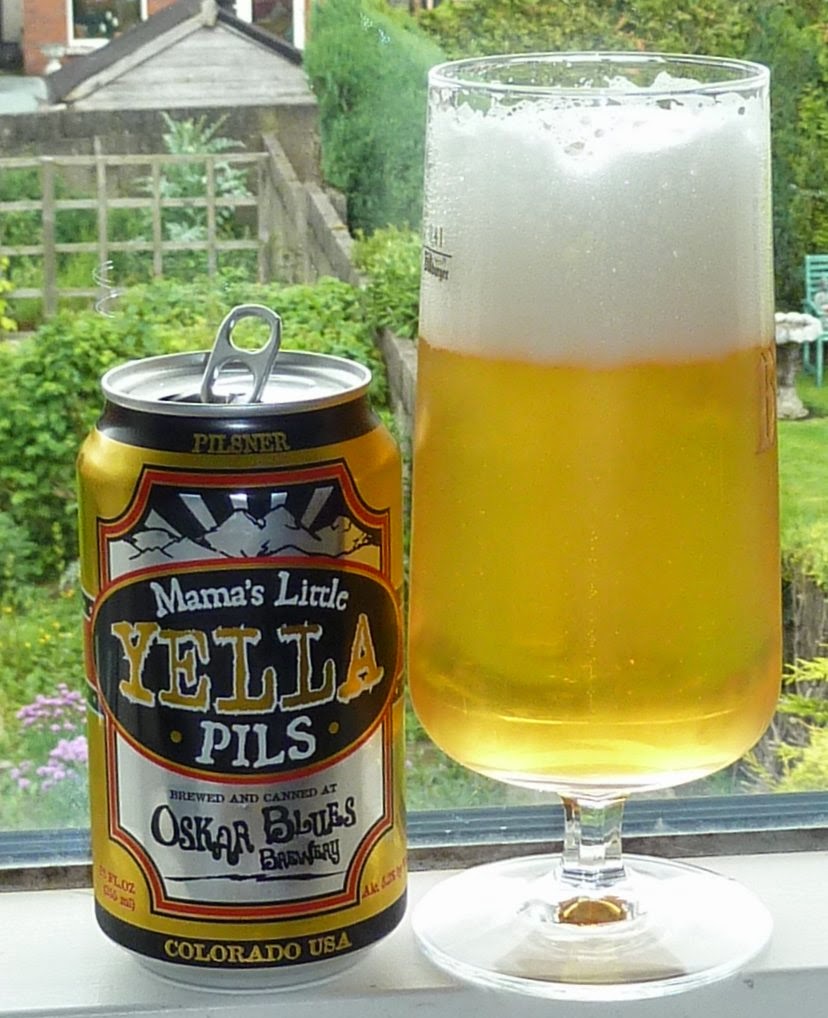![]() |
| I have no idea what's in these glasses |
Even though it has an on-site brewery and is a staunch supporter of local beer, the Hanging Bat beer café in Edinburgh can generally be relied on for a selection of English beers, especially from the more interesting and progressive breweries south of the border. And the readily available third-pint measures means ticking one's way through them is disturbingly easy. So...
A burgundy-aged version of The Kernel's Table Beer? Gimme.
Bière de Table is a stonking 4.5% ABV and a very pale shade of yellow. There's little sign of wine or wood in the flavour, this highly attenuated beer being light, cold, clean and very refreshing. There's a very mild sourness but it barely impacted on the rich succulent Hanging Bat pulled pork. There was similar refreshment power in Rooster's
Fort Smith: a lovely light lemony zip from the 5% ABV golden ale.
On the dark beer front, I found
Henley Dark porter a bit sickly. The summer fruit aroma is enticing but the big milk chocolate gets quite cloying, even when only drinking a third of it.
Railway Porter by London's Five Points is an unctuous coffee-laden affair with lots of oiliness and a strong liquorice bitterness. If you're in the mood for a coffee flavoured beer, this will keep you happy but it's not going to be for everyone. Best of the lot was the
Dunkel Bock by Harbour Brewing, a long way from home in Cornwall. It's the appropriate shade of red-brown and with an unfussy mix of chocolate, coffee and bourbon biscuit, but then there's also a beautiful fresh green-hop nose which puts it ahead of any German version of the style I've ever tasted. Beautifully drinkable and one I'd be happy to have a larger measure of.
![]() |
| Evolver, probably |
And IPAs? The 'Bat's got 'em. The nearest thing to ordinary was
The Devil <3s Cascade by Summerwine, a big and sticky 7.2%-er, dark orange and almost headless. The unctuous candy malts are well balanced by a similarly oily resinous hop character, producing a peachy aroma followed by a more serious bitter pine flavour. Bit of a knife-and-fork job, but fun in small measures. Siren's
Das Soundwave was the lightest of the bunch, a German-hopped IPA of 5.6% ABV, greenish gold in colour with a zingy orange sherbet aroma. There's a lot of heavy hop dank in the flavour and it leaves with a mouth-watering mandarin flourish. Overall, extremely drinkable yet marvellously complex. The outlier was
Evolver from the Wild Beer Co. and I almost didn't order it. The description marks it as a brett IPA and I wondered who in their right minds would want something like that? Why soil the lovely fresh taste of hops with the dirty funk of brettanomyces yeast? I'm glad I ran out of options and had one before I left because it was gorgeous: soft peach and juicy mandarin to the fore, only funked up a little by some well-mannered brett. It's a beautiful blend of what the two elements bring to a beer, reminiscent of fresh Orval only with brighter, more exciting hops.
![]()
I returned to the Hanging Bat a couple of days later on a Sunday afternoon, hoping to catch a beer or two from the in-house brewery. But there was none of that, the blackboard was looking a little bare, and the place was loud and packed, so I nipped round the corner to the altogether more civilised Blue Blazer. No stuffy old-man beer here, however: I opted for
2014, a black IPA from Arbor Ales. It's 7% ABV and so densely black I could feel it draining colour from the pints on neighbouring tables. You get a
big hop burn from the first pull: pine, mostly, but with some flowery perfume, a pinch of gunpowder and a generous helping of boiled cabbage. Light relief is provided by a squirt of grapefruit zest, but mostly this is a very serious beer. The dark malts and heavy texture lend a tarry burnt flavour, with a tiny hint of bitter dark chocolate peeping through the seventeen other kinds of bitterness it offers. Amazing stuff, and very good value, since it takes
ages to drink.
![]()
I mentioned
previously that there was a themed range of beers at the Bow Bar for Anzac Day. England was represented by
Bitter Kiwi from Bristol Brewing. This is one of the best exhibition beers for Nelson Sauvin I've ever encountered. The aroma is beautifully flinty, like ultra-dry Sauvingnon Blanc, with a little bit of added peach nectar, and this theme continues in the flavour: dry white grape, some lychee and succulent sweet peach. Not bitter at all in fact, and not even a trace of cat piss, which is a win.
![]()
A bottle of Hobson's
Kiss Me Now had found its way north with a family member. This claims to be a stout but its soft plumminess made me think more of warming winter ale, even at just 4.3% ABV. Keeping it sessionable, I found Cullercoats
Lovely Nelly on cask, an oddly tart dark gold ale with strange but pleasant strawberry notes. Brewed as a lifeboat fundraiser, it's ironically very sinkable. This was back at the Cask & Barrel on Broughton Street where they also had
Broughton Street Domestic Ale on. Never pass up the house beer is one of my rules. Turns out this is a re-badging of Gladiator Bitter, brewed by Hadrian and Border. First impressions are of an unexciting 3.9% ABV brown bitter: biscuity, shading towards twigginess, but a couple of sips in I got a sudden jolt of summer fruit: redcurrants and raspberries. A session bitter deserving of a second chance, then.
![]()
Last cask ale of the trip was at the airport where the Wetherspoon had the tail end of their latest international beer festival available in the form of
Saint Archer Pale Ale, ostensibly from Saint Archer in San Diego but actually brewed at Banks's in Wolverhampton. It's good stuff: a healthy layer of dank hops livened by some lighter peachy notes and set on a light easy-going golden malt base. The perfect gulp-and-go airport beer in fact.
Judging from this lot, the Edinburgers are picky about which English beers they let in, and reap the rewards it brings.
 I happened to be in the UK when Boak and Bailey announced that they were hosting the 88th round of The Session. Unfortunately I wasn't in one of the good bits, so my plans to pick some new-to-me British beers in traditional styles for mixing was somewhat scuppered by the awful selection at Sainsbury's in Armagh, itself the nearest thing to a decent off licence open in the town on a Sunday.
I happened to be in the UK when Boak and Bailey announced that they were hosting the 88th round of The Session. Unfortunately I wasn't in one of the good bits, so my plans to pick some new-to-me British beers in traditional styles for mixing was somewhat scuppered by the awful selection at Sainsbury's in Armagh, itself the nearest thing to a decent off licence open in the town on a Sunday.
 The result is closer in colour to Reserve than Gold, just a little bit paler. And the flavour combination does actually sort-of work: the floral honey element is the first thing to come through, but instead of a simple lager-fizz base, it's sitting on the summer fruits from the Reserve, conjuring a marvellously bucolic picture of copse-smattered rolling downs. English with a capital E. You can almost hear the birdsong. The tannins haven't quite disappeared but only flash briefly right at the very end. But it's neither sticky nor watery and actually quite a decent, balanced complex English session bitter. I really didn't want to use the hackneyed "greater than the sum of its parts" in this review, but it's apt nonetheless.
The result is closer in colour to Reserve than Gold, just a little bit paler. And the flavour combination does actually sort-of work: the floral honey element is the first thing to come through, but instead of a simple lager-fizz base, it's sitting on the summer fruits from the Reserve, conjuring a marvellously bucolic picture of copse-smattered rolling downs. English with a capital E. You can almost hear the birdsong. The tannins haven't quite disappeared but only flash briefly right at the very end. But it's neither sticky nor watery and actually quite a decent, balanced complex English session bitter. I really didn't want to use the hackneyed "greater than the sum of its parts" in this review, but it's apt nonetheless.




























































